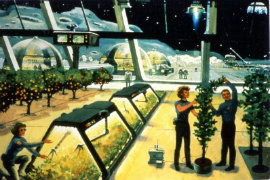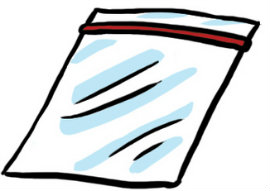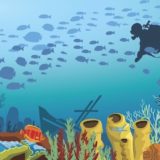STEM Face Off: Which Lesson Makes the Grade?
A MiddleWeb Blog

The problem I face when searching for online STEM lessons, or when looking at books purporting to offer STEM lessons, is that quite a few of them don’t seem to be STEM lessons – at least not according to the way the National Academies of Science and of Engineering view K-12 STEM. (See my recent post STEM 2015: Are We Losing Our Focus? for more about these definitions.)
To explain what I mean, I’ve put together brief synopses of two lessons. Both are billed as STEM instruction. Based on your current thinking about STEM, what do you think? Are they both STEM lessons?
Sample Lesson 1: Growing Crops for a Lunar Biosphere

Each student team selects a different crop. All teams then follow the same set of procedures and start their crops from seeds, planting them in plastic containers that will be tightly closed. The amount of light is held constant for all containers so that the only variable is the plant size and mass. As team members monitor the growth of their crops, they track crop height and growth rates. Teams take photos of the crops at different stages in the growth cycle.
At the end of four weeks students harvest the crops, measure the mass of the crops (after drying them), and determine which crops produced the highest mass yields. They compare and analyze data across teams, and select crops they believe to be good candidates for producing food and biomass in a lunar biosphere.
Each team writes a technical report to an imaginary NASA Lunar Engineering Team, recommending the specific crops they selected.
Sample Lesson 2: Designing an Air Cushion to protect fallers from injury

The teams begin by studying acid-base reactions. Each team has access to a variety of materials and figures out a way to produce a predictable, controlled acid-base reaction inside a plastic bag. Team members then investigate the amounts of sodium bicarbonate and acetic acid that they think will produce enough gas (carbon dioxide) to inflate a gallon-size plastic bag to a size that would protect a person falling – not allow that person to touch the ground or bounce off the cushion.
Each team constructs its air cushion. Teams evaluate the success of their air cushions based on the condition of a model faller (a portion cup with 10 pennies) dropped onto the cushion from a height of 1½ meters.
Teams compare their air cushion designs with those of other teams, collect data on the results of all drops, and construct scatterplots. They then use the information to redesign their airbags to increase their effectiveness.
Each team videos a successful test and includes the video with a technical report to a company that will market this product.
So what do you think? STEM or not STEM?
For what it’s worth, here’s my take, based on the original vision of STEM:
> Both lessons involve science AND mathematics – a must for K-12 STEM, which is viewed as an integrated curriculum involving science, technology, engineering, and mathematics.
> Both involve teamwork – another “must have” for STEM curriculum.
> Both involve a student-centered, hands-on approach.
> Both focus on a real-world problem.
> Both involve collecting and analyzing data, although with different degrees of depth.
Although both lessons share these five characteristics, at this point the similarity to an actual STEM lesson begins to dwindle for Lesson #1.
Where the lessons diverge
Consider the design aspect. Lesson #1 offers students no choice (except for the plant type) in designing the solution. All teams are given the same approach to follow to set up their biospheres. Lesson #2, on the other hand, allows team members to work together to design the mix of chemicals, a way to combine the chemicals within a plastic bag, and the degree to which the bag is inflated to be successful. Each team may come up with a different mix of chemicals and amount of inflation. Lesson #2 permits multiple possible solutions for the problem.
Consider the process of designing and creating prototypes. This was absent in Lesson #1, but was front and center in Lesson #2. In Lesson #2 teams experimented with the chemicals and used this research to choose a design they believed would solve the problem. Each team then created an air cushion prototype from their design.
Consider the testing process. Lesson #1 offered no reason to do anything beyond gathering data about the mass of the plants. Lesson #2 involved teams in conducting actual tests of their air cushions and comparing the data graphically. That gave them information to help in redesigning their air cushions as needed.
The all-important engineering component
In my view, Lesson #1 did not fully match the criteria for a STEM lesson. Actually, Lesson #1 is a great science experiment and could qualify as research for designing a lunar biosphere. It followed the scientific method quite nicely, but it lacked an actual engineering application.
Lesson #2 contained that all-important engineering component – the component that drives real STEM lessons and projects. It followed the engineering design process and called on students to create their own research-based solutions for the problem (within constraints). This reinforced an engineering mindset of continual improvement and redesign.
 Good lessons aren’t always STEM lessons
Good lessons aren’t always STEM lessons
Many worthwhile lessons and projects focus on student-centered learning, innovation, creativity, teamwork, design approaches, and some of the same skills that STEM projects focus on. For that reason, many people think of these as STEM.
However, recall that STEM was introduced into the K-12 curriculum to meet specific (engineering-related) needs in our national workforce, as well as to create STEM-literate citizens. For that reason, I’d suggest sticking with the original purpose of STEM in our K-12 program designs. Let’s keep that all-important engineering component front and center.
Image credit: Lunar farm, Space Science Institute


 Good lessons aren’t always STEM lessons
Good lessons aren’t always STEM lessons

































I think this is a really handy site for teachers and parents alike to understand middle school kids! Makes a good impression and a must read.
Glad you like MiddleWeb, Christopher! As a former middle school teacher I really think this is THE best, most practical website out there for middle school teachers.
This is a great synopsis of the difference between a science lab and a STEM lesson, Anne! I am working with new Science teachers online with the New Teacher Center and can’t wait to share this with my mentees. Hopefully get some “aha” moments!
Thanks, Caroline! Knowing of your work, this makes me glad I can take part in it in some way. Let me know of their reactions – positives and pushbacks.
Couldn’t you modify the first lesson to make it more STEM? Perhaps by learning about what minerals are available in lunar rock and testing how little you would need to ship from earth, so each group would pick and plant and grow it in different types of soil? And also look at the nutrients in the crops and analyze the whole class or multiple classes worth of data to see which plants grew best in different soils to make a balanced diet?
You can absolutely modify this lesson to make it fit STEM criteria. Basically what it lacks is an engineering challenge and prototype design. So you’d have to figure out, What’s the problem that needs to be solved?
What we did was change the biosphere setting to Mars because by that time NASA was focusing on Mars and we wanted this to be as realistic as possible. Then the students’ challenge was to design an efficient growth system for Mars that would produce at least 100 grams of plant mass on the average.The kids brainstormed multiple ideas for how what combination of inputs (soil quantity, water, and seed type) they would need to efficiently produce as much biomass as possible. Each team built its own system (using the plastic containers) but these were no longer cookie cutter. They used math to analyze the efficiency rates based on the inputs and how well the system worked.
Can you see how the tweaks put this lesson into the STEM category – the kids weren’t using cookie cutter procedures to grow plants and simply determining which plant grew better. Each team did research on the plants and made informed decisions about how it wanted to create its own growth system that produced maximum biomass – then evaluated the effectiveness of their growth system prototype.
I hope this makes some sense. Thank you for wrestling with this problem.
Thanks for this. I might even argue that #2 has limited possibilities as presented and might be richer if there was more than one way to approach the problem. We are struggling with this at our school at the moment. Not all STEM activities are STEM and teachers without a lot of STEM experience have a hard time weeding through.
You’re so right, Dana! The difficulty we always seem to face is that the problem needs to address specific science/math objectives, and we are limited in the materials we can reasonably provide for 6 classes per science/math teacher. So we had to structure it more than we wanted to because of those constraints.
I found this to be such a thoughtful examination of this issue. The clarity you offer here – well, I know a lot of folks who will find this useful, I’ll be sharing this!
Thank you, Annie! I truly have examined this issue over a period of 8 years as I’ve worked with STEM experts and written STEM curriculum. STEM components may be incorporated into other subjects; however using a STEM practice (hands-on activities, for example) doesn’t mean you have a STEM curriculum.
Anne, I love this approach to defining the what and how of STEM curriculum. It makes it so easy for teachers to see and understand that just doing something experiential, even if it is science, is not STEM. And also that science is great, but it is not STEM. It really shows how all of the pieces integrate and how to take a science lesson and transform it into STEM. You do a great job not only to clarify what is what, but also explaining why and how-to. It gives teachers the tools to help themselves. Thanks!
Thanks for your comments, Ruth. One of the hardest things to get across is why a typical science experiment is usually not STEM. When the “light” comes on, science teachers can generally turn some of their favorite experiments into great STEM lessons. That’s an approach I really recommend – start with a lesson you like (and that kids like) and tweak that into a STEM lesson.